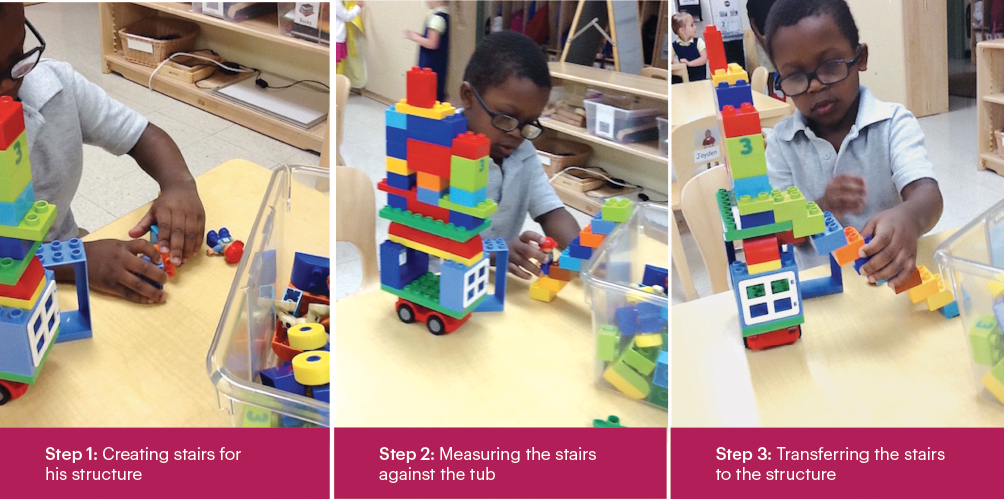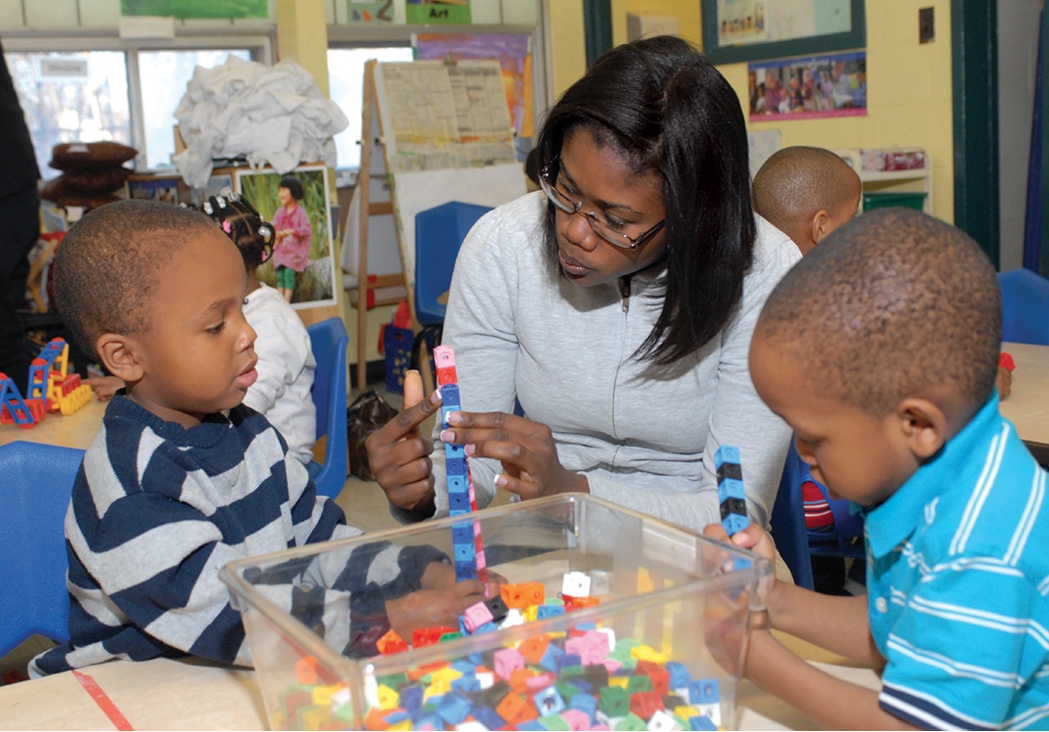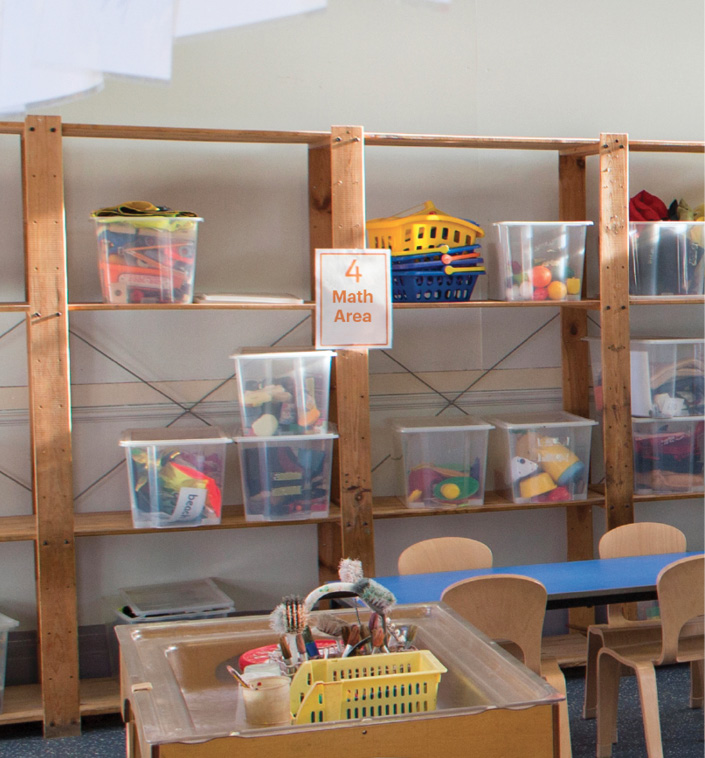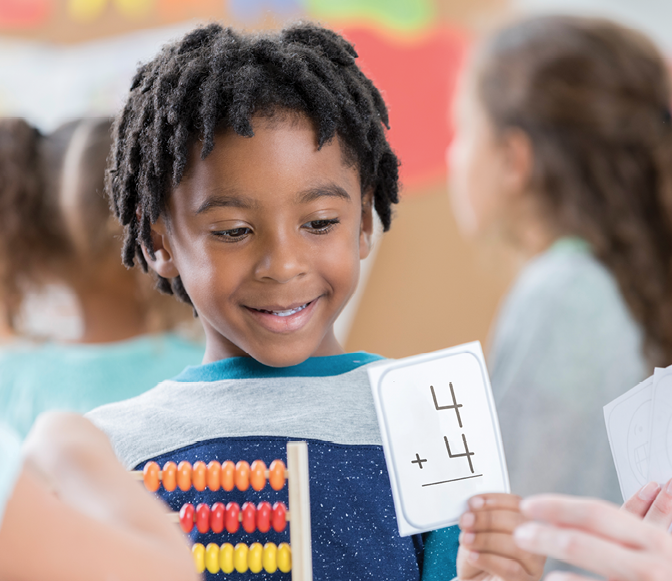Positive Early Math Experiences for African American Boys: Nurturing the Next Generation of STEM Majors

You are here
In a prekindergarten classroom in an impoverished section of the city, Ms. Shepherd announced to the children that they were all going for a walk in the neighborhood. Her theme for that month was buildings.
During the walk the class came upon a house under renovation where the construction workers and electricians were happy to take a break to talk to the children. The children paid rapt attention to measurement, construction plans, and plum lines and levels. Over the next few weeks, Ms. Shepherd and the children returned to the building site several times, observing from a safe vantage point as the house took shape, cheering on the carpenters.
Back in the classroom, the children engaged in a variety of hands-on activities centered on buildings. Children created buildings in the block area, taking tools and measuring devices from the math center to help with their construction. The teacher assistant outlined a skyline of the city for the dramatic play area and the children added the windows and finishing touches to the mural. The class also interviewed a father who worked for a construction company, and he spent one morning showing the children the basics of how to measure and assemble a house. Throughout Ms. Shepherd’s building theme, mathematical content was integrated everywhere!
Fostering young children’s interest in math centers can be difficult. Children often overpopulate the dramatic play, art, and block areas but may have little interest in exploring the math center without prompting. This past year, we (as university-based researchers and consultants) have been intensively observing the math centers in eight publicly funded prekindergarten classrooms in a southern city. We sought to understand children’s natural interactions with math manipulatives and materials during center time. All of the classrooms were relatively well supplied with math-related materials, but in some cases the centers were not set up to foster children’s sustained interest or develop their mathematics understanding. Materials were similar across classrooms, but they did not change over time and were not organized in ways that provoked students’ curiosity or attention.
Two major research findings support the importance of mathematics learning in urban prekindergarten classrooms that primarily serve children of color. One is that early math knowledge is a strong predictor of later school success—in reading as well as math (Duncan et al. 2007). The other is that racial disparities in children’s math achievement are present at kindergarten entry (Friedman-Krauss 2016)—and these gaps remain large throughout elementary, middle, and high school (National Assessment of Educational Progress 2015).
In this article, we argue that creating engaging early math-learning opportunities is critical, especially for African American boys, and we recommend choosing materials and designing environments to optimize early math learning.
Supporting African American boys
At an early age, African American boys become aware of racialized stereotypes regarding their own math abilities (Nasir & Shah 2011). On average, African American boys are overrepresented in negative educational outcomes and underrepresented in positive outcomes. Although it is well established that these disparities are due to a wide range of issues regarding opportunities to learn (see Bowman, Comer, and Johns in this issue), a misperception remains among some members of the public (including some educators) that these disparities are due to innate differences in abilities. As a result, many African American boys are often confronted with lowered expectations even when they are high achieving(Berry III 2008; Zilanawala et al. 2017). Lowered expectations can lead to these children being denied access to rigorous math curricula, feeling unsupported in their math trajectories, and developing a negative attitude toward or perception of their abilities to do math (i.e., their self-efficacy) (Berry III 2008; Nasir & Shah 2011). Making matters worse, new research finds that young children’s attitudes toward math are a powerful predictor of their achievement, even after controlling for cognitive abilities (Chen et al. 2018; Digitale-Stanford 2018).
Setting expectations and attitudes aside, research also finds clear disparities in access to high-quality math learning across educational settings. Young children of color attending urban schools in low-income areas tend to have fewer opportunities to master math knowledge. A study of urban prekindergarten classes showed that math teaching and activities take place much less frequently than literacy teaching and activities (Farran et al. 2017). Studies have also found that in the elementary grades (and beyond) African Americans are underrepresented in gifted programs. For example, a careful examination of gifted referrals in kindergarten, first grade, and third grade found that when Black children had a Black teacher, they were far more likely to be referred and assigned to gifted programs than when they had a non-Black teacher (Grissom & Redding 2016). Given these disparities in opportunities to learn throughout early childhood and elementary school, perhaps it should come as no surprise that, according to the National Assessment of Educational Progress (2015), only 13 percent of African American eighth-grade boys were proficient in math, compared with 43 percent proficiency among White boys.
Generally, urban schools, elementary through high school, in low-income areas do not have the rigorous math curricula or high-quality math instruction necessary to engage children and youth in deep math learning or to prepare students for college-level math courses. As a consequence, in higher education institutions, African American students are being assigned to remedial math courses at a higher rate than their White peers (Chen 2016; Preston 2017).
Early exposure to high-quality math environments is increasingly important in determining students’ career trajectories. In 2002, according to the National Science Foundation, African American college students received only seven percent of the science, technology, engineering, and mathematics (STEM) bachelor’s degrees awarded. In 2014, this percentage remained roughly unchanged. While STEM careers have typically been male dominated, this is not the case among African Americans. Fewer than half of the STEM degrees awarded to African Americans in 2014 went to males (National Science Foundation 2017).
African American males’ accomplishments in mathematics remain an under-researched topic, especially from an early childhood perspective. Many successful African American men who have STEM careers have attributed their achievement largely to positive early math experiences. This suggests that by offering more challenging and supportive math learning environments—especially when children are young—teachers can improve children’s math proficiency and, over time, open doors to STEM careers (Berry III 2008; McGee & Pearman II 2014; Zilanawala et al. 2017).
Providing engaging early math experiences is not simple. Significant efforts—such as reducing teacher turnover, increasing spending, and hiring more qualified teachers—have had little impact on improving African American males’ math trajectories (Zilanawala et al. 2017). Increasing math involvement in early childhood classrooms serving children of color from low-income families requires fundamentally rethinking math learning opportunities.
 Exposure to high-quality early math experiences and environments allows children to plan, focus, and build on past experiences—actions that develop executive function skills. These skills include the ability to suppress distracting information, shift attention between multiple components of a task, and retain and process information, all of which facilitate learning and performance in the classroom (Fitzpatrick et al. 2014; Clements, Sarama, & Germeroth 2016). Engaging in math activities—like playing board games and sorting toys into sets (by color, shape, etc.)—enriches these essential skills.
Exposure to high-quality early math experiences and environments allows children to plan, focus, and build on past experiences—actions that develop executive function skills. These skills include the ability to suppress distracting information, shift attention between multiple components of a task, and retain and process information, all of which facilitate learning and performance in the classroom (Fitzpatrick et al. 2014; Clements, Sarama, & Germeroth 2016). Engaging in math activities—like playing board games and sorting toys into sets (by color, shape, etc.)—enriches these essential skills.
The connection between math and executive function is especially important for children growing up in low-income homes and under-resourced communities, which as of 2016, included 34 percent of Black children (Annie E. Casey Foundation 2018). Recent neurological evidence shows that the areas of the brain most affected by early exposure to poverty are the ones related to executive function skills and reasoning (Noble et al. 2015). Because children from low-income families and under-resourced communities tend to have less-predictable routines and be exposed frequently to high-stress environments, they are less likely than children from wealthier families to have well-developed executive function and math skills (Ursache & Noble 2016). Boys in particular have a hard time focusing and persisting without strong environmental support, and boys from low-income, high-stress households have the most difficulty. Younger children are more dependent on the organization of the environment than older children. It is important to note that environmental support does not mean more teacher direction and control. Often, it means creating a math learning center that has enticing math materials, minimal distractions, and accessible organization to direct children’s attention. The choice of materials matters (as we outline in the article), with some offering more support for learning than others.
To learn more about the development of executive function skills and mathematical abilities, see “From Design Copying to Mathematics in the Early Childhood Classroom” in the March 2018 issue of Young Children.
Choosing appropriate math materials
Through our work with teachers, we’ve seen that the supply of products and programs on the market claiming to facilitate math learning can be overwhelming. Based on questions from teachers, and on the day-to-day challenges we observed in their classrooms, we developed the following guidelines and strategies for selecting appropriate math materials and using them in enriching ways.
Provide sequential activities
In early childhood, the most effective math materials involve sequential learning. Sequential materials give children a logical order or sequence of steps to follow and often involve children creating a working plan. Using these types of materials, children engage in higher-order thinking, planning, reflecting, and problem solving. More engagement in sequential activities is linked to higher gains during preschool in both math and self-regulation skills (Farran et al. 2017). Examples of sequential materials for 3- to 5-year olds could include tangrams (matching patterns of increasing complexity); peg-sorting boards; and learning cubes with design cards (3-D construction based on 2-D pictures).
Select materials that give children feedback
While teacher-directed math instruction is important, math centers should help children learn independently as well. Materials that automatically provide feedback (sometimes called autodidactic or self-correcting) allow children to independently see when they have made a mistake. A simple example is a jigsaw puzzle with pieces that only fit together one way. The self-correcting feature allows children to extend their initial ideas into sustained math learning while enhancing working memory (Kirschner, Sweller, & Clark 2006; Willingham 2017).
Many successful African American men in STEM careers have attributed their achievement largely to positive early math experiences.
When choosing math materials, teachers should consider how much support children are likely to need to understand and learn from the activity. An introduction and sporadic support may be reasonable, but if children are likely to need continuous support, the product may not be appropriate for the math center. Puzzles are often great examples of autodidactic materials. In one common puzzle that teaches shapes and one-to-one correspondence, each shape has a particular number of holes that correspond with pegs on the puzzle board.
Offer problem-solving opportunities
Extending children’s initial interest involves setting high expectations and inviting children to make sense of the world through problem solving. Positive early math experiences are a wonderful way to foster young children’s natural curiosity. In our observations, we have found that boys are often attracted to open-ended building materials such as Legos, Bamboo Blocks, and Magna-Tiles because they allow for exploration and creativity. However, without some additional assistance, children may not use these materials in ways that provoke deeper thinking. Teachers should scaffold children’s play, increasing challenges, and sparking new explorations over time.
Materials such as Legos and Magna-Tiles allow students to plan elaborate structures if teachers provide some assistance. Pictured below is a young boy independently engaged in building stairs for a structure. To determine the height of the stairs, he measured the stairs against the height of the Lego container. This required the boy to complete several phases of rebuilding and remeasuring to ensure that the stairs fit the structure properly. After several attempts, he was able to transfer the stairs to the structure, and the stairs fit. Play like this—involving complex problem solving—is essential to developing the executive function skills (e.g., shifting attention between multiple components of a task) discussed in “Why Is Math So Important?”. While solving this challenge, he remained deeply engaged in his project for the remainder of math center time (roughly half an hour). Providing models (like a laminated poster of stairs) with corresponding plans to follow and suggestions from the teacher can help children enjoy the cognitive benefits—and fun—of more sophisticated play.

Add a variety of explicit math content
In the prekindergarten classrooms we observed, many of the materials in math centers were variations of sorting and block building. But there is much more to math learning than these two activities. Moreover, sorting and building can happen without children actually learning much math. Boys may be attracted to these types of activities, but the math center should represent a wide range of math content, from patterns to counting and cardinality to spatial relations. Materials that do not at first seem math related can become so with the addition of supporting resources. For example, we have observed that children often used counting bears for dramatic play. If children do not know how to count, having counting bears will not, by itself, teach them. However, adding a lazy Susan with numerals or dots (or a combination of either with color coding) to the counting bears can provide children with actual math learning. The lazy Susan allows children to physically count the quantity of counting bears and match it to the quantity of dots displayed on the lazy Susan (i.e., one-to-one correspondence).
We often saw Bristle Blocks in math centers even though they teach little to no math. While some spatial learning may occur with materials like Bristle Blocks, too often children merely attach them without reference to constructing a shape. For Bristle Blocks to enhance math, teachers need to add some creative suggestions for how children can interact with the blocks. Teachers can take advantage of how attractive the blocks are to children by adding measuring tapes, rulers, and suggestions for their usage, giving children a means to use these materials mathematically.
Avoid materials that distract from math learning
Teachers need to be aware of the nonmathematical aspects of materials and activities that may compete for children’s attention. For example, young children are often distracted by the features of a math manipulative, particularly color, and may have trouble recognizing the mathematical concept (Willingham 2017). Teachers need to consider if color is being used for mathematical purposes (such as comparing the quantities of red cars and blue cars) or if it is simply a distraction (such as a rainbow of hues in a game intended to focus on one-to-one correspondence or counting on).

It is important to note that materials in which a nonmathematical concept is redundant with the mathematical concept may impair children’s math learning. For instance, many materials that aim to focus on sorting allow for both numerical and color sorting; examining these materials, it is clear that very often children could sort entirely by color and be correct without attending to the math features at all. In addition, recent research has shown that preschoolers can become overstimulated by materials with mulitple features and can have trouble distinguishing which one is most relevant (Willingham 2017). When materials have multiple features, children may need support to identify and attend to the mathematical aspects. For independent learning in math centers, materials with a minimal number of distracting features may be more effective.
Organize, label, and rotate materials
 Young children are highly dependent on the organization of the environment to be able to engage with math materials in a meaningful way. Creating a space that is neatly organized, labeled, and engaging will garner far more attention than a poorly arranged center. When children can easily see all available materials, they can better plan their math-related play, be it building a pyramid or copying a design or sorting toy animals into different types of sets (perhaps by tail length). Maintaining their interest throughout the year requires adding new materials and/or enhancing old materials with new resources that allow children to do more with what is at hand. For example, teachers could provide children with sets of pattern blocks and simple designs to copy. As the children gain mastery, teachers can add more complex designs and invite children to create their own using the shapes. Teachers can also expand this design copying using other materials, such as beads or LEGOs.
Young children are highly dependent on the organization of the environment to be able to engage with math materials in a meaningful way. Creating a space that is neatly organized, labeled, and engaging will garner far more attention than a poorly arranged center. When children can easily see all available materials, they can better plan their math-related play, be it building a pyramid or copying a design or sorting toy animals into different types of sets (perhaps by tail length). Maintaining their interest throughout the year requires adding new materials and/or enhancing old materials with new resources that allow children to do more with what is at hand. For example, teachers could provide children with sets of pattern blocks and simple designs to copy. As the children gain mastery, teachers can add more complex designs and invite children to create their own using the shapes. Teachers can also expand this design copying using other materials, such as beads or LEGOs.
Containers for materials are often labeled to make cleanup easier, but there is a more important benefit to labeling. Appropriately labeling materials with photos and/or text helps children access them easily. Labels can also be enhanced to remind children of more challenging ways to play with the materials. Children can then independently navigate centers, making informed decisions and plans about what supplies to work with. Many materials fit well into tubs that are easy to label. Oddly shaped and large materials can be placed on labeled shelves.
Refreshing materials after every unit of study by adding new items and changing the supporting materials helps re-engage children and maintain their attention. For example, if counters are currently present in the math center and are only used to practice one-to-one correspondence, the teacher can add pattern cards that prompt children to use the counters in new ways. There is not one prescribed timeframe in which teachers should rotate materials. Fewer children choosing the math center is a strong indication that the materials need updating.
Conclusion

Fostering high-quality early math experiences can have a tremendous effect on the long-term school success and career trajectories of African American males. While the guidelines we have outlined here are beneficial to all preschoolers, they are critically important to male children of color. Far too many schools are not providing the vigorous math activities, materials, and supports that children of color need, hampering their opportunities to later engage in advanced math courses or enter STEM-related fields.
Early childhood teachers can foster productive math experiences for African American boys by having positive individual interactions, providing opportunities for exploration, extending children’s initial interests, and structuring the environment to continuously attract and engage children in math learning.
The way in which teachers and parents approach and communicate the importance of math learning has a direct link to a young boy’s perception of his ability to enjoy and excel in math. It also impacts his self-regulation skills. Therefore, making math a meaningful and inviting experience is vital in all early childhood classrooms—especially those serving African American boys growing up in under-resourced communities.
Resources for Teachers
-
“Ask the Cognitive Scientist: Do Manipulatives Help Students Learn?” by Daniel T. Willingham
www.aft.org/sites/default/files/periodicals/ae_fall2017_willingham.pdf -
“Good Attitude about Math Gets Kid Brains in High Gear,”
by Erin Digitale-Stanford
www.futurity.org/positive-attitude-math-brains-1665192 -
“It Doesn’t Add Up: African American Students’ Math Achievement,” by Gloria Ladson-Billings
http://393methods1.wikispaces.com/file/view/Ladson-Billings,+G.+(1997).pdf - “Playful Math Instruction in the Context of Standards and Accountability,” by Deborah Stipek.
Resources from the Partnership for Developing Model Early Learning Centers website (https://my.vanderbilt.edu/mnpspartnership/), a collaboration between the Peabody Research Center at Vanderbilt University and the Metro Nashville School System:
- Tips on providing early math activities https://my.vanderbilt.edu/mnpspartnership/teaching-resources/providing-math-opportunities/
-
Tips on fostering involvement and student interest
https://my.vanderbilt.edu/mnpspartnership/teaching-resources/fostering-high-levels-of-involvement/ -
Tips on increasing engagement during centers
https://my.vanderbilt.edu/mnpspartnership/2017/01/engagement-during-centers-invited-blog-post/ -
Tips on implementing sequential activities during center time
https://my.vanderbilt.edu/mnpspartnership/files/2016/07/Supporting-Sequential.pdf
References
Annie E. Casey Foundation. 2018. “Children in Poverty by Race and Ethnicity.” Kids Count Data Center. http://datacenter.kidscount.org/data/tables/44-children-in-poverty-by-ra....
Berry III, R.Q. 2008. “Access to Upper-Level Mathematics: The Stories of Successful African American Middle School Boys.” Journal for Research in Mathematics Education 39 (5): 464–88.
Bowman, B., J. Comer, & D. Johns. 2018. “Addressing the African American Achievement Gap: Three Leading Educators Issue a Call to Action.” Young Children 73 (2):12–21.
Chen, X. 2016. “Remedial Coursetaking at US Public Two and Four Year Institutions: Scope, Experiences, and Outcome.” US Department of Education. Washington, DC: National Center for Education Statistics. https://nces.ed.gov/pubs2016/2016405.pdf.
Chen, L., S.R. Bae, C. Battista, S. Qin, T. Chen, T.M. Evans, & V. Menon. 2018. “Positive Attitude toward Math Supports Early Academic Success: Behavioral Evidence and Cognitive Mechanisms.” Psychological Science, January.
Clements, D.H., J. Sarama, & C. Germeroth. 2016. “Learning Executive Function and Early Mathematics: Directions of Causal Relations.” Early Childhood Research Quarterly 36 (3): 79–90.
Digitale-Stanford, E. 2018. “Good Attitude about Math Gets Kid Brains in High Gear.” Futurity. www.futurity.org/positive-attitude-math-brains-1665192/.
Duncan, G.J., C.J. Dowsett, A. Claessens, K. Magnuson, A.C.Huston, P. Klebanov, L.S. Pagani, L. Feinstein, M. Engel, J. Brooks-Gunn, H. Sexton, K. Duckworth, & C. Japel. 2007. “School Readiness and Later Achievement.” Developmental Psychology 43 (6): 1428–46.
Farran, D.C., D. Meador, C. Christopher, K.T. Nesbitt, & L.E. Bilbrey. 2017. “Data-Driven Improvement in Prekindergarten Classrooms: Report from a Partnership in an Urban District.” Child Development 88 (5): 1466–79.
Fitzpatrick, C., R.D. McKinnon, C.B. Blair, & M.T. Willoughby. 2014. “Do Preschool Executive Function Skills Explain the School Readiness Gap between Advantaged and Disadvantaged Children?” Learning and Instruction 30 (1): 25–31.
Friedman-Krauss, A. 2016. “How Much Can High-Quality Universal Pre-K Reduce Achievement Gaps?” Preschool Matters Today (blog). National Institute for Early Education Research. http://nieer.org/2016/03/31/how-much-can-high-quality-universal-pre-k-reduce-achievement-gaps.
Grissom, J.A., & C. Redding. 2016. “Discretion and Disproportionality: Explaining the Underrepresentation of High-Achieving Students of Color in Gifted Programs.” AERA Open 2 (1): 1–25.
Kirschner, P.A., J. Sweller, & R.E. Clark. 2006. “Why Minimal Guidance during Instruction Does Not Work: An Analysis of the Failure of Constructivist, Discovery, Problem-Based, Experiential, and Inquiry-Based Teaching.” Educational Psychologist 41 (2): 75–86.
McGee, E.O., & F.A. Pearman II. 2014. “Risk and Protective Factors in Mathematically Talented Black Male Students: Snapshots from Kindergarten through Eighth Grade.” Urban Education 49 (4): 363–93.
Nasir, N.S., & N. Shah. 2011. “On Defense: African American Males Making Sense of Racialized Narratives in Mathematics Education.” Journal of African American Males in Education 2 (1): 24–45.
NAEP (National Assessment of Educational Progress). 2015. “2015 Mathematics and Reading Assessments.” The Nation’s Report Card. www.nationsreportcard.gov/reading_math_2015/#?grade=4.
NSF (National Science Foundation). 2017. Women, Minorities, and Persons with Disabilities in Science and Engineering. Arlington, VA: NSF. www.nsf.gov/statistics/2017/nsf17310/digest/about-this-report/.
Noble, K.G., S.M. Houston, N.H. Brito, H. Bartsch, E. Kan, J.M. Kuperman, N. Akshoomoff, D.J. Amaral, C.S. Bloss, O. Libiger, N.J. Schork, S.S. Murray, B.J. Casey, L. Chang, T.M. Ernst, J.A. Frazier, J.R. Gruen, D.N. Kennedy, P. Van Zijl, S. Mostofsky, W.E. Kaufman, T. Keret, A.M. Dale, T.L. Jernigan, & E.R. Sowell. 2015. “Family Income, Parental Education, and Brain Structure in Children and Adolescents.” Nature Neuroscience 18 (5): 773–78.
Preston, D.C. 2017. Untold Barriers for Black Students in Higher Education: Placing Race at the Center of the Developmental Education. Atlanta, GA: Southern Education Foundation.
Ursache, A., & K. Noble. 2016. “Neurocognitive Development in Socioeconomic Context: Multiple Mechanisms and Implications for Measuring Socioeconomic Status.” Psychophysiology 53 (1): 71–82.
Willingham, D.T. 2017. “Do Manipulatives Help Students Learn?”Ask the Cognitive Scientist. American Educator.
Zilanawala. A., M. Martin, P.A. Noguera, & R.B. Mincy. 2017. “Math Achievement Trajectories among Black Male Students in the Elementary- and Middle-School Years.” Educational Studies 1–22.
Photographs: 1, 2, 3, 5 © Getty Images; 6, courtesy of the authors; 4, © Ken Alswang
Danielle B. Davis, BSEd, is a graduate research assistant at the Peabody Research Institute and a masters of public policy candidate at Vanderbilt University. This project was supported by the Heising Simons Foundation and DREME Network (Development and Research in Early Math Education). [email protected]
Dale C. Farran, PhD, is the Antonio and Anita Gotto Chair in Teaching and Learning at Vanderbilt University, director of the Peabody Research Institute, and a member of the DREME Network. She has partnered with the Metro Nashville Public Schools Pre-K program for four years. [email protected]